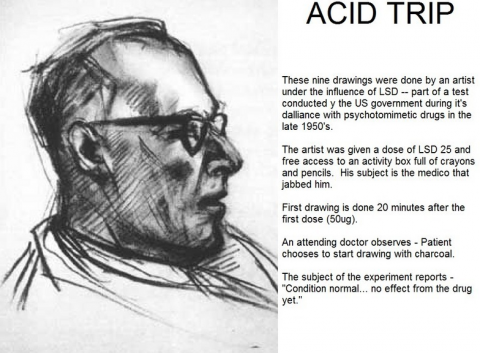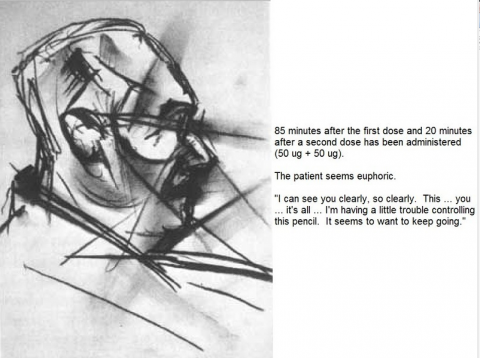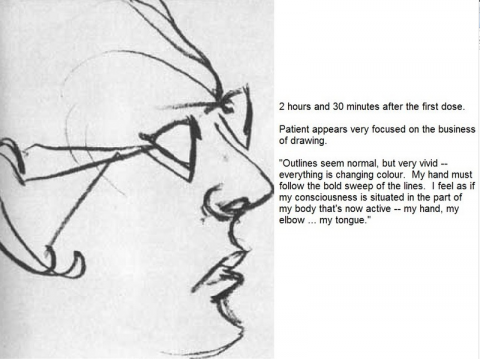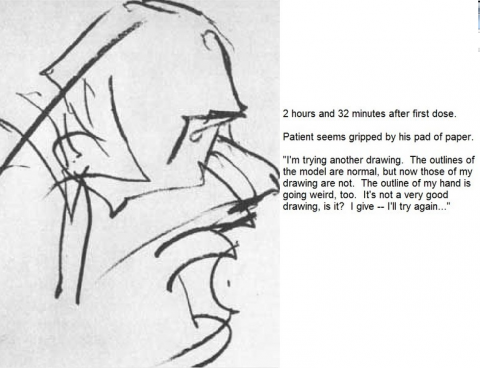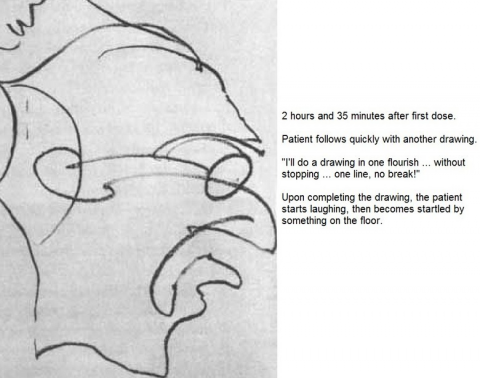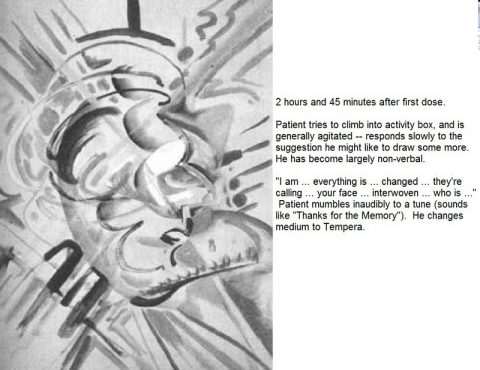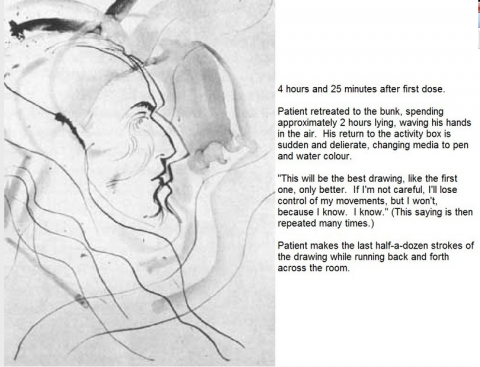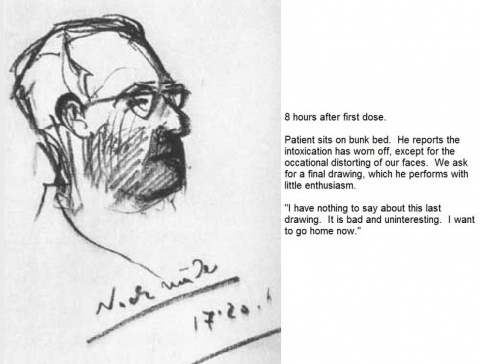[Most Recent Entries] [Calendar View]
Thursday, May 2nd, 2024
| Time | Event |
| 8:00a | Artist Draws 9 Portraits on LSD During 1950s Research Experiment During the 1950s, a researcher gave an artist two 50-microgram doses of LSD (each dose separated by about an hour), and then the artist was encouraged to draw pictures of the doctor who administered the drugs. Nine portraits were drawn over the space of eight hours. We still don’t know the identity of the artist. But it’s surmised that the researcher was Oscar Janiger, a University of California-Irvine psychiatrist known for his work on LSD. The web site Live Science has Andrew Sewell, a Yale Psychiatry professor (until his recent death), on record saying: “I believe the pictures are from an experiment conducted by the psychiatrist Oscar Janiger starting in 1954 and continuing for seven years, during which time he gave LSD to over 100 professional artists and measured its effects on their artistic output and creative ability. Over 250 drawings and paintings were produced.” The goal, of course, was to investigate what happens to subjects under the influence of psychedelic drugs. During the experiment, the artist explained how he felt as he worked on each sketch. You can watch how things unfolded below (or above): 20 Minutes After First Dose. Artist Claims to Feel Normal 85 Minutes After First Dose: Artist Says “I can see you clearly. I’m having a little trouble controlling this pencil.” 2 hours 30 minutes after first dose. “I feel as if my consciousness is situated in the part of my body that’s now active — my hand, my elbow… my tongue.” 2 hours 32 minutes: ‘I’m trying another drawing… The outline of my hand is going weird too. It’s not a very good drawing is it?” 2 hours 35 minutes: Patient follows quickly with another drawing. ‘I’ll do a drawing in one flourish… without stopping… one line, no break!” 2 hours 45 minutes: Agitated patient says “I am… everything is… changed… they’re calling… your face… interwoven… who is…” He changes medium to Tempera. 4 hours 25 minutes: After taking a break, the patient changes to pen and water color. “This will be the best drawing, like the first one, only better.” 5 hours 45 minutes. “I think it’s starting to wear off. This pencil is mighty hard to hold.” (He is holding a crayon). 8 hours later: The intoxication has worn off. Patient offers up a final drawing. Related Content: R. Crumb Describes How He Dropped LSD in the 60s & Instantly Discovered His Artistic Style Algerian Cave Paintings Suggest Humans Did Magic Mushrooms 9,000 Years Ago |
| 9:00a | RIP Paul Auster: Hear the Master of the Postmodern Page-Turner Discuss How He Became a Writer In the Louisiana Channel interview clip from 2017 above, the late Paul Auster tells the story of how he became a writer. Its first episode had appeared more than twenty years earlier, in a New Yorker piece titled “Why Write?”: “I was eight years old. At that moment in my life, nothing was more important to me than baseball.” After the first big-league game he ever went to see, the New York Giants versus the Milwaukee Braves at the Polo Grounds, he came face-to-face with a legend-to-be named Willie Mays. “I managed to keep my legs moving in his direction and then, mustering every ounce of my courage, I forced some words out of my mouth. ‘Mr. Mays,’ I said, ‘could I please have your autograph?’ ” Mays says yes, but there was a problem: “I didn’t have a pencil, so I asked my father if I could borrow his. He didn’t have one, either. Nor did my mother. Nor, as it turned out, did any of the other grownups.” Eventually, the young Auster’s idol “turned to me and shrugged. ‘Sorry, kid,’ he said. ‘Ain’t got no pencil, can’t give no autograph.’ And then he walked out of the ballpark into the night.” From that point on, as the middle-aged Auster tells it, “it became a habit of mine never to leave the house without making sure I had a pencil in my pocket.” Even in this childhood anecdote, readers will recognize some of Auster’s signature elements: the icons of mid-century New York, the life-changing chance encounter, the state of bitter regret. But it takes more than a pencil to become a writer. “The thing about doing this, which is unlike any other job, is that you have to give maximum effort, all the time,” Auster says. “You have to give every ounce of your being to what you’re doing, and I don’t think there are many jobs that require that. You see lazy lawyers, lazy doctors, lazy judges. They can get through things. You even see lazy athletes.” But “you can’t be a writer or a painter or a musician unless you make maximum effort.” Even after producing nothing usable in one of his usual eight-hour writing shifts, “I can at least stand up and say, at the end of the day, I gave it everything I had. I tried 100 percent. And there’s something satisfying about that, just trying as hard as you can to do something.” There’s something thoroughly American about these words, as indeed there’s something thoroughly American about Auster’s twenty postmodern page-turners (to say nothing of his many volumes of nonfiction and poetry). Yet he also had one foot in France, where he lived in the early nineteen-seventies, and several of whose respected writers — Sartre, Mallarmé, Blanchot — he translated into English. He gained his first and most fervent fanbase there, becoming a beloved écrivain american of long standing. The announcement of his death on April 30th must have set off something like a national day of mourning, and an occasion to remember what he once said to France Inter: just as a writer should always carry a pencil, “chacun doit être prêt à mourir n’importe quand.” Related content: Hear Paul Auster Read the Entirety of The Red Notebook, an Early Collection of Stories Paul Auster Reads from New Novel Sunset Park Read and Hear Famous Writers (and Armchair Sportsmen) J. M. Coetzee and Paul Auster’s Correspondence Philip Roth Predicts the Death of the Novel; Paul Auster Counters Based in Seoul, Colin Marshall writes and broadcasts on cities, language, and culture. His projects include the Substack newsletter Books on Cities, the book The Stateless City: a Walk through 21st-Century Los Angeles and the video series The City in Cinema. Follow him on Twitter at @colinmarshall or on Facebook. |
| << Previous Day |
2024/05/02 [Calendar] |
Next Day >> |

